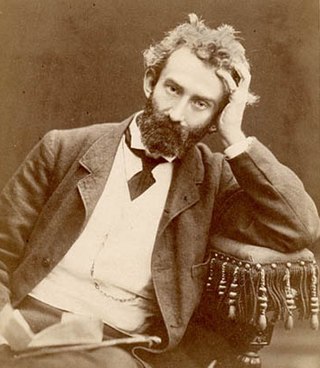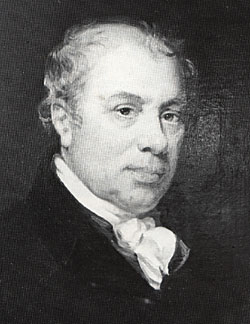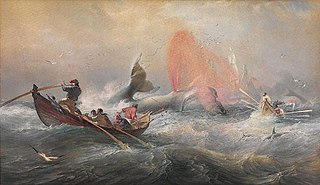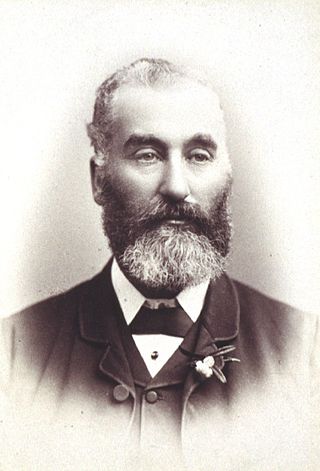Related Research Articles

Andrew Inglis Clark was an Australian founding father and co-author of the Australian Constitution; he was also an engineer, barrister, politician, electoral reformer and jurist. He initially qualified as an engineer, but he re-trained as a barrister to effectively fight for social causes which deeply concerned him. After a long political career, mostly spent as Attorney-General and briefly as Opposition Leader, he was appointed a Senior Justice of the Supreme Court of Tasmania. Despite being acknowledged as the leading expert on the Australian Constitution, he was never appointed to the High Court of Australia.
The history of Tasmania begins at the end of the Last Glacial Period when it is believed that the island was joined to the Australian mainland. Little is known of the human history of the island until the British colonisation of Tasmania in the 19th century.

Nicholai Nikolaevich Miklouho-Maclay was a Russian explorer of Ukrainian origin. He worked as an ethnologist, anthropologist and biologist who became famous as one of the earliest scientists to settle among and study indigenous people of New Guinea "who had never seen a European".

Thomas Barbour was an American herpetologist. He was the first president of the Dexter School in 1926. From 1927 until 1946, he was director of the Harvard Museum of Comparative Zoology (MCZ) founded in 1859 by Louis Agassiz at Harvard University in Cambridge, Massachusetts.

Henry Ogg Forbes was a Scottish explorer, ornithologist, and botanist. He also described a new species of spider, Thomisus decipiens.

Sir William John Macleay was a Scottish-Australian politician, naturalist, zoologist, and herpetologist.

Alexander MacleayMLC FLS FRS was a Scottish-Australian leading member of the Linnean Society, a fellow of the Royal Society and member of the New South Wales Legislative Council.

SY Aurora was a 580-ton barque-rigged steam yacht built by Alexander Stephen and Sons Ltd. in Dundee, Scotland, in 1876, for the Dundee Seal and Whale Fishing Company. It was 165 feet (50 m) long with a 30-foot (9.1 m) beam. The hull was made of oak, sheathed with greenheart and lined with fir. The bow was a mass of solid wood reinforced with steel-plate armour. The heavy side frames were braced by two levels of horizontal oak beams. Its primary use was whaling in the northern seas, and it was built sturdily enough to withstand the heavy weather and ice that would be encountered there. That strength proved useful for Antarctic exploration as well and between 1911 and 1917 it made five trips to the continent, both for exploration and rescue missions.

Whaling in Australian waters began in 1791 when five of the 11 ships in the Third Fleet landed their passengers and freight at Sydney Cove and then left Port Jackson to engage in whaling and seal hunting off the coast of Australia and New Zealand. The two main species hunted by such vessels in the early years were right and sperm whales. Humpback, bowhead and other whale species would later be taken.

John MacGillivray was a Scottish naturalist, active in Australia between 1842 and 1867.
Leonard Rodway was an English-born Australian dentist and botanist.

Elizabeth Bay House is a heritage-listed Colonial Regency style house and now a museum and grotto, located at 7 Onslow Avenue in the inner eastern Sydney suburb of Elizabeth Bay in the City of Sydney local government area of New South Wales, Australia. The design of the house is attributed to John Verge and John Bibb and was built from 1835 to 1839 by James Hume. The grotto and retaining walls were designed by Verge and the carriage drive on Onslow Avenue was designed by Edward Deas Thomson and built from 1832 to 1835 by convict and free artisans under the direction of Verge. The property is owned by Sydney Living Museums, an agency of the Government of New South Wales. Known as "the finest house in the colony", Elizabeth Bay House was originally surrounded by a 22-hectare (54-acre) garden, and is now situated within a densely populated inner city suburb.
The Queen Victoria Museum and Art Gallery (QVMAG) is a museum located in Launceston, Tasmania, Australia. The QVMAG is the largest museum in Australia not located in a capital city.

The Tasmanian Museum and Art Gallery (TMAG) is a museum located in Hobart, Tasmania. The museum was established in 1846, by the Royal Society of Tasmania, the oldest Royal Society outside England. The TMAG receives 400,000 visitors annually.

Richard Godfrey Rivers, generally known as R. Godfrey Rivers, was an English artist, active in Australia and president of the Queensland Art Society from 1892–1901 and 1904–08.

Sir John George Davies, generally known as (Sir) George Davies, was a Tasmanian politician, newspaper proprietor and first-class cricketer.

Joseph Boss Williams Woollnough was an Australian politician and Anglican church minister. He was a prominent figure in the Anglican church in Tasmania from his arrival to take up a senior church role in 1883, the member for Sorell in the Tasmanian House of Assembly from 1893 to 1903 and the owner of the historic former Model Prison at Port Arthur from 1889 until his death.

Henry Hunter (1832–1892) was a prominent architect and civil servant in Tasmania and Queensland, Australia. He is best known for his work on churches. During his life was also at various times a state magistrate of Tasmania, a member of the Tasmanian State Board of Education, the Hobart Board of Health, a Commissioner for the New Norfolk Insane Asylum and President of the Queensland Institute of Architects.

George Masters (1837-1912) was a zoologist, active in Australia during the 19th century.
The Chevert expedition was a scientific expedition to collect natural history samples from New Guinea and the Torres Strait. It was led and financed by William John Macleay, the first president of the Linnean Society of New South Wales. Chevert sailed from Sydney on 18 May 1875 and returned in September that year. Scientific specimens collected included approximately 1,000 birds, 800 fish, reptiles, insects, molluscs, plants and ethnographic objects. There are conflicting accounts of the number of crew members who were present during the expedition, with certain sources there were 30 members, and others claiming 31. The scientific personnel on board were Sir William Macleay, John Brazier, William Petterd and Edward Spalding, Thomas Reedy, and William James.
References
- 1 2 3 4 5 6 7 Peter Mercer (1986). "Alexander Morton (1854–1907)". Australian Dictionary of Biography Volume 10. National Centre of Biography at the Australian National University. Retrieved 9 April 2024.
- 1 2 "Alexander Morton (1854–1907)". The Mercury (Hobart). 28 May 1907.
- ↑ "Family Notices". The Mercury (Hobart) . Vol. XLV, no. 4, 491. Tasmania, Australia. 11 July 1884. p. 1. Retrieved 29 July 2023– via National Library of Australia.
- ↑ Macleay, W. (1883). "Contribution to a knowledge of the fishes of New Guinea, No. 4". Proceedings of the Linnean Society of New South Wales. 8 (2): 252–280.
- ↑ "Scientific Names where Species Equals mortoni". Fishbase. Retrieved 9 April 2024.